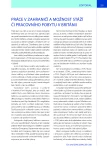-
Medical journals
- Career
SELECTIVE CLAMPING ROBOTIC-ASSISTED NEPHRECTOMY
Authors: Jiří Kočárek 1,2; František Chmelík 1; Jiří Heráček 1,2; Markéta Matějková 1; Milan Čermák 1
Authors‘ workplace: Urologické oddělení, Ústřední vojenská nemocnice – Vojenská fakultní nemocnice Praha 1; Urologická klinika, 1 lékařská fakulta, Univerzita Karlova v Praze 2
Published in: Ces Urol 2016; 20(4): 257-258
Category: Video
Overview
Introduction:
Currently, kidney-sparing interventions (partial nephrectomies) are recommended for all patients with T1 or T2 tumors. Minimally invasive surgical approaches for interventions on the kidneys are associated with a lower morbidity without the deterioration of oncological results. The modern robotic system da Vinci with the possibility of fluorescent imaging using indocyanine green (ICG) facilitates the identification of segmental renal arteries and ensures safe selective clamping. Nowadays, robotic assistance offers minimally invasive surgery for all candidates of open partial nephrectomy.Description of the clinical case:
Since January 2014, we performed 52 robot-assisted partial nephrectomies using ICG using the Da Vinci robotic system type Si. Operations are performed in the lumbotomy position. Camera port is introduced through the umbilicus, for patients with higher BMI in the pararectal line. Two 8 mm robotic ports are located in the medioclavicular line. One 12 mm port for the assistant is located cranial or caudal to the camera port depending on the tumor location in the kidney. The identification of the renal artery and the preparation of the segmental branches are the first steps. After loading the vascular clamps ICG is applied intravenously. The starting dose is 1.5 ml with the concentration of 2.5 mg/ml ICG. After 5 to 10 seconds we are able to identify with fluorescent imaging the individual parts of the kidney without blood flow. The partial nephrectomy is then performed in the displayed ischemic segment. Upon finishing the suture and removal of vascular clamps, ICG is reapplyed to check the quality of blood flow of the kidney and the range of the ischemic area given the suture of the defect.Conclusion:
Robot-assisted partial nephrectomy is a safe method for the treatment of renal cell carcinoma. Selective clamping with fluorescence control reduces the risk of ischemic renal damage.Key words:
Indocyanine green, minimally invasive approaches, partial nephrectomy, robotic-assisted surgery
Labels
Paediatric urologist Nephrology Urology
Article was published inCzech Urology

2016 Issue 4-
All articles in this issue
- URINARY SYMPTOMS IN PATIENTS WITH MULTIPLE SCLEROSIS. AS UROLOGISTS, ARE WE IMPORTANT IN THE ALGORITHM OF SPECIALIZED CARE OF PATIENT WITH MULTIPLE SCLEROSIS?
- DYSFUNCTIONS OF LOWER URINARY TRACT IN DIABETIC PATIENTS
- RECOMMENDATIONS FOR DIAGNOSIS AND MANAGEMENT OF NOCTURIA IN THE CZECH REPUBLIC
- PROGNOSTIC SIGNIFICANCE OF PARAMETERS ARISING FROM THE RATIO OF NEUTROPHILS AND LYMPHOCYTES IN INVASVIE BLADDER NEOPLASMS
- PROGNOSIS OF PATIENTS WITH MODERATE AND HIGH-RISK NON-MUSCLE-INVASIVE BLADDER CANCER TREATED WITH INTRAVESICAL INSTILLATIONS OF MITOMYCIN C DURING UNAVAILABILITY OF BCG VACCINE
- BLADDER SPARING TREATMENT FOR MUSCLE-INVASIVE BLADDER CANCERS
- OUR FIRST EXPERIENCE WITH THE COMET ASSAY IN THE STUDY OF SPERM DNA INTEGRITY
- RARE HISTOLOGICAL FINDING OF A MALIGNANT TUMOR ARISING FROM RENAL ENDOMETRIOSIS
- HIBERNOMA AS A SURPRISING FINDING DURING PERIRENAL TUMOUR EXSTIRPATION
- 62ND CZECH UROLOGICAL SOCIETY ANNUAL CONFERENCE IN ČESKÉ BUDĚJOVICE 2016
- SELECTIVE CLAMPING ROBOTIC-ASSISTED NEPHRECTOMY
- Czech Urology
- Journal archive
- Current issue
- Online only
- About the journal
Most read in this issue- PROGNOSTIC SIGNIFICANCE OF PARAMETERS ARISING FROM THE RATIO OF NEUTROPHILS AND LYMPHOCYTES IN INVASVIE BLADDER NEOPLASMS
- BLADDER SPARING TREATMENT FOR MUSCLE-INVASIVE BLADDER CANCERS
- URINARY SYMPTOMS IN PATIENTS WITH MULTIPLE SCLEROSIS. AS UROLOGISTS, ARE WE IMPORTANT IN THE ALGORITHM OF SPECIALIZED CARE OF PATIENT WITH MULTIPLE SCLEROSIS?
- RECOMMENDATIONS FOR DIAGNOSIS AND MANAGEMENT OF NOCTURIA IN THE CZECH REPUBLIC
Login#ADS_BOTTOM_SCRIPTS#Forgotten passwordEnter the email address that you registered with. We will send you instructions on how to set a new password.
- Career

